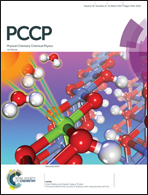Models for biomedical interfaces: a computational study of quinone-functionalized amorphous silica surface features†
Abstract
A density functional theory (PBE functional) investigation is carried out, in which a model of an amorphous silica surface is functionalized by ortho-benzoquinone. Surface functionalization with catechol and quinone-based compounds is relevant in biomedical fields, from prosthetic implants to dentistry, to develop multifunctional coatings with antimicrobial properties. The present study provides atomistic information on the specific interactions between the functionalizing agent and the silanol groups at the silica surface. The distinct configurations of the functional groups, the hydrogen bond pattern, the role of dispersion forces and the simulated IR spectra provide detailed insight into the features of this model surface coating. Ab initio molecular dynamics gives further insights into the mobility of the functionalizing groups. As a final step, we studied the condensation reaction with allylamine, via Schiff base formation, to ground subsequent simulations on condensation with model peptides of antimicrobial activity.



 Please wait while we load your content...
Please wait while we load your content...